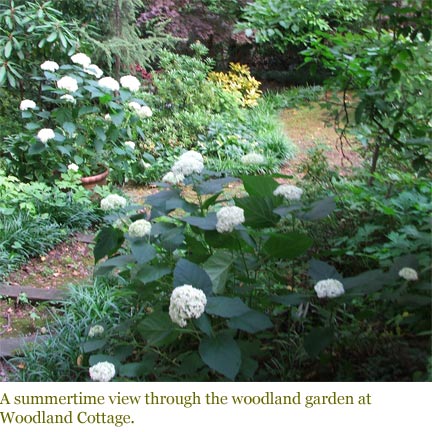|
 ear Clients and Friends, ear Clients and Friends,

As the heat and dry weather continue, it pays to monitor your garden’s water needs. Make sure you are watering enough, but not too much—see notes below:
When trees are rooted and growing leaves, they are taking up water from the ground. It's like suction (and much like our sweating): the leaves "sweat", and in the process, pull the water from the ground with the roots, up through the plant, and out through the leaves. This is called transpiration. The hotter, drier, and sunnier, the faster the transpiration, thus the increased water need. It's like a continuous loop of water drawn in and sweated out. When the days shorten in the fall, they anticipate the coming cold weather, drop their leaves, and go dormant. Evergreens just go dormant, of course—all the plants just stop from the ground up. The roots will continue to grow until the ground gets below 40 degrees. This is all very simplistic, of course—so much more is going on, but you get the drift.
Things are different when a plant is first planted. That's because they take time to root—in other words, the little feeder roots that take up the water have not yet come from the rootball of the transplanted plant and established themselves into the surrounding soil. So we have to baby them for a few weeks until this happens. Too little water, and they drop their leaves as a defense mechanism because they are trying to conserve water in the stems so that when water is again available, they have the strength saved up to leaf out again. Conversely, when too much water is around the roots and the rootball cannot get any oxygen (because this is important, too), the plant drops its leaves because it doesn't need any water and the systems shut down. Both of these things are really easy to do when plants are just put in—there is a fine balance. Believe it or not, more plants die of overwatering than under watering. Isn't that crazy? But it's true.
As the days shorten, and the sun becomes less intense as we move towards fall, your plants will require less and less water…you can probably cut the frequency a bit. Likewise, plants dry out more quickly when the humidity is low; less quickly when the humidity is high. So monitor carefully so you don’t over- or under-water. Just remember to soak deeply when you do water.

Get to know your garden and its “hot spots”—places that dry more quickly than others. This is true even if you have an irrigation system. Put your fingers under the mulch, into the soil, and check for moisture. Don’t depend on a quick thunderstorm to water for you…deep soak your garden as needed. Let the lawn go dormant or provide once inch of water per week to keep it green. If hand–watering your plants, take the nozzle off the hose, and aim that nice, steady stream of water directly at the center of the plant where it meets the soil. Let the water soak in deeply. When using sprinklers, rain gauges are a big help…or (better) check the soil with your fingers. And remember: like winter-damaged plants, those left unwatered are not guaranteed—another incentive to get out the hose!
Do your best to keep up with it. A two to three inch (no more, and not against the trunks or stems, please) layer of mulch helps deter weed growth (after you’ve pulled the weeds by the roots, of course). Preen weed preventer seems to help, too, though it is not a cure-all.
Monitor carefully and treat appropriately.
Spring-blooming shrubs should not be pruned any more until after they bloom next spring. If you cut them now, you will likely cut off next spring’s blooms. The buds have set. You can continue to prune hedges, trees and non-blooming evergreens, as needed.
“Dead-head” (cut off the old blooms) from your perennials and some annuals to help extend blooming. This goes for roses, too. It’s time to get your fall vegetable garden going. Wait until the heat breaks to plant pansies, mums and other fall flowers so they don’t bloom themselves out. Wait until cool weather to plant spring-flowering bulbs. Be sure to deeply water.
Questions on anything? Let me know. More info to come as we move into autumn.
Stay cool, enjoy your vacations and best regards,

P.S. You can forward this newsletter to a friend by clicking the blue forward E-mail link below at left.
|



